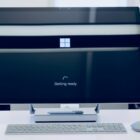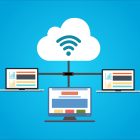The transition to hybrid working
Working from home, or from anywhere remotely, has been made possible with the collective efforts of tech companies, constantly looking for new solutions and innovations to improve the experience of their business customers. In the current climate, we are starting to see a big shift in the working arrangement of companies from a home office to a hybrid workplace, which poses new technological challenges and security risks.
Hybrid working has been gaining more momentum in the corporate world thanks to a large number of benefits for the employees and loosening of local and global restrictions. Changing the workplace arrangements, however, requires a more refined approach from IT companies, which need to consider the individual needs of employees and provide effective technical resolutions in response to these demands.
What is hybrid working?
If you haven’t already heard or utilized a hybrid model at your workplace, you are more than likely to experience this in one way or another. Hybrid working is a new term for flexible working which requires or asks the employee to split their time between a physical workplace and a home office. In 2021, we are expecting to see over 90% of the global workforce move to some type of hybrid operations. This trend highlights the importance of integrating new solutions, software, and features in the hybrid strategy of the company – which must be able to support all employees and keep productivity levels satisfactory for all parties.
In this article, we are looking at several hybrid working solutions which are utilized by cloud customers, using Desktop-as-a-Service (DaaS) to make the shift more seamless for both employers and employees.
Better employee experience
One of the hardest challenges for new employees who joined the remote working force in 2020 and 2021 was the inability to meet with co-workers and exchange ideas in a non-virtual environment. Staying connected to a team or the wider business proved to be a real challenge for new starts and temporary staff. Platforms like Viva by Microsoft resolved some of these challenges by giving the new hybrid working force a place to foster company culture and stay in touch with the wider business. This is a platform, rather than an app, designed to act as a portal for the employees and managers to navigate through the difficulty of working from home. It is divided into 4 sections: Insights, Topics, Connections, Topics, and Learning. Viva can be integrated into your Microsoft Teams suite as a cloud client. If you use Azure Desktop or virtual desktops from third-party providers (Microsoft Silver and Gold Partners), you can easily have Viva deployed to your employee desktops with the aim to increase their virtual experience and promote better work well-being. In the end, we say we agree with the description of this unique platform by the head of Microsoft-Saparo, referring to it as: ” gateway to your digital workplace ” , or a gateway to the hybrid working place.
When we speak of hybrid models or hybrid working, we must mention video conferencing and how this function has been improved in recent times. The most challenging thing about having a conference call between the teams that are on-site and the ones that are connected remotely is the levels of engagement and productivity during these online meetings. When you have a big part of the team working from a remote location, you would like everyone to be equally involved and proactive despite being far apart. This is where Microsoft Teams came in and resolved another pressing challenge of the hybrid working world that companies were facing.Microsoft built an extra feature to the software, called ‘Front row’, and made another improvement to the user interface so that remote workers can be attending the hybrid working place with a better experience.
BYOPC programs
One of the most popular approaches in remote and hybrid working space in the last year was the program Bring-Your-Own-PC (BYOPC). Similar to Bring-Your-Own-Device, this program enabled many remotely operating employees to continue working in a hybrid model or fully remotely. We can agree that it helped the workforce, more than it helped the employers. Personal devices of employees are rarely to be trusted against malicious attacks like ransomware , malware, spyware, or else. This challenge has also been resolved in the hybrid working world by virtual desktops and cloud-hosted services. Companies nowadays can rely on their cloud provider to deploy a smoothly running and secure desktop environment, which works seamlessly with their BYOPC strategy for hybrid working.
All in all, we can agree that moving from remote to hybrid working still poses some challenges to companies. Nevertheless, we see that we have the tools, features, and technologies like cloud desktops and advanced conferencing applications, which give all users a better experience in the workplace-remote, hybrid or what’s next in the digital era.






